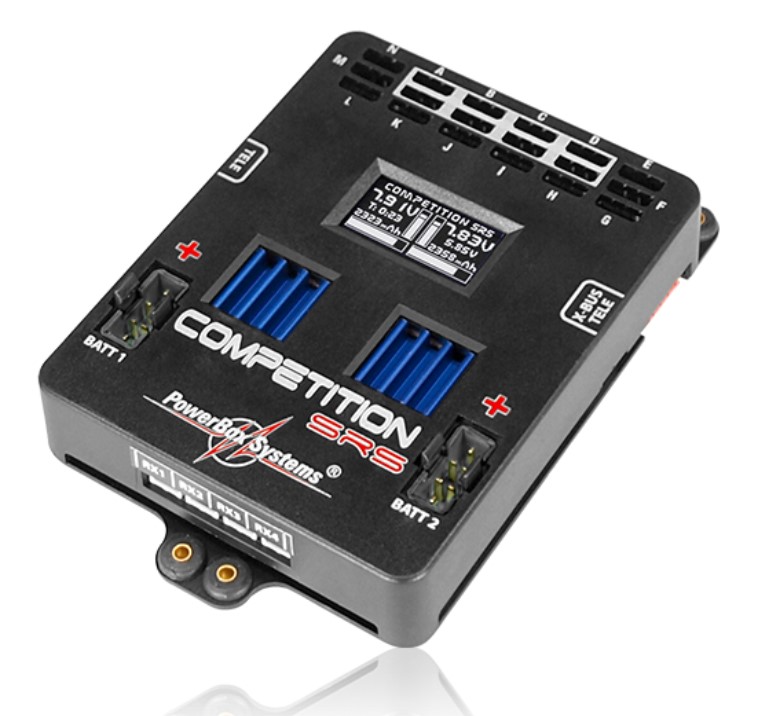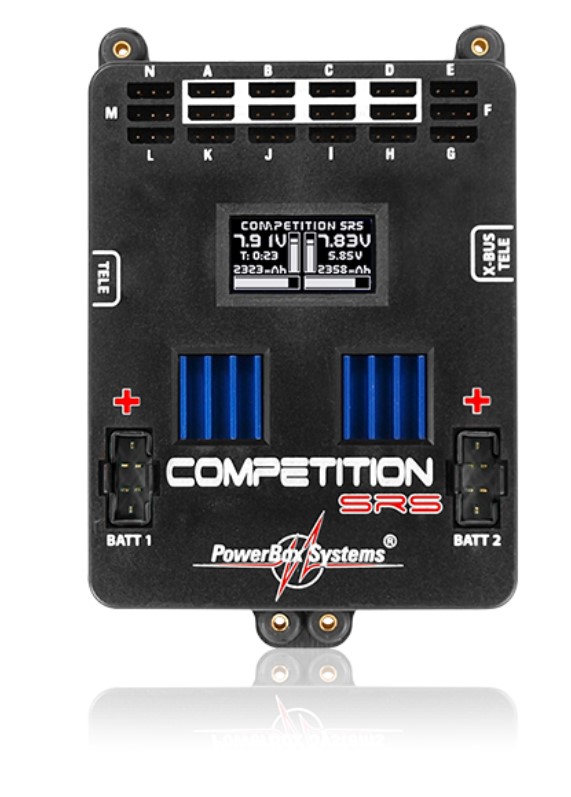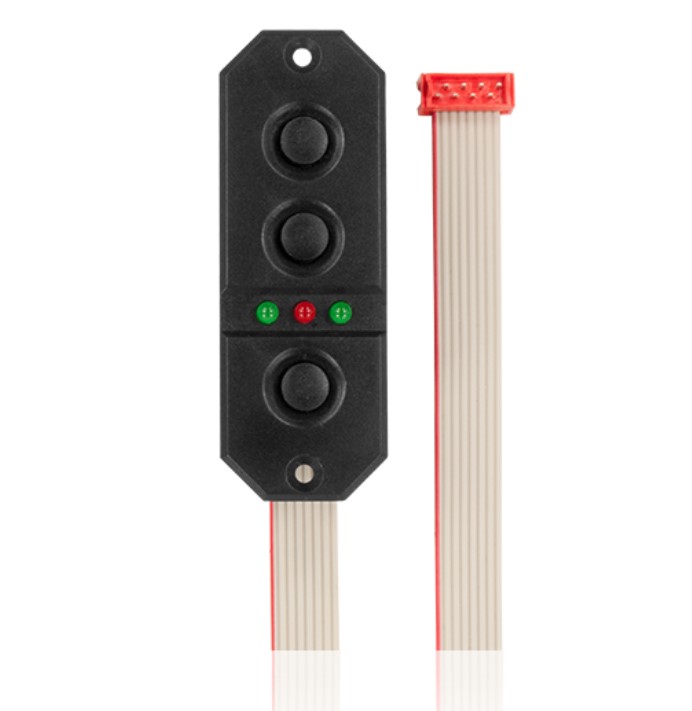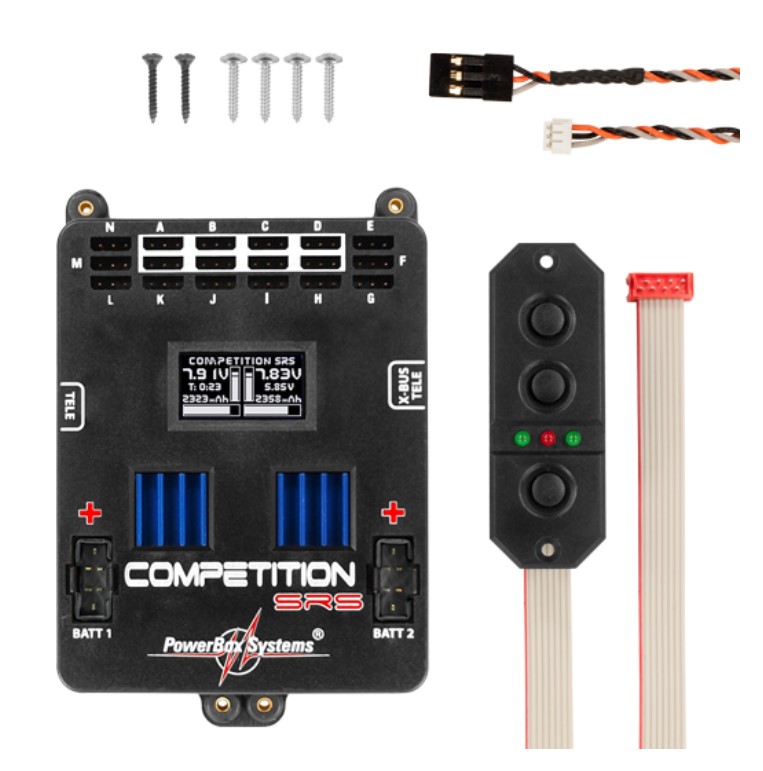The PowerBox Competition SRS is the first device in an entirely new generation of power supply systems, and since its introduction it has grown to be the most popular product in our range.
Available again from the beginning of October.
Features
- SRS: Serial Receiver System provides the facility to use receivers with serial interface: Spektrum DSM2 and DSMX (incl. X-Plus channels), Multiplex M-Link, Futaba S-Bus, HoTT, JR X-BUS and Jeti R-SAT2 (PPM, EX and UDI)
- Servo-Match function: servo centre, end-points and reverse for 4 channels and 8 servos
- Unrestricted channel assignment for all PowerBox outputs
- Graphic OLED screen with 128 x 64 pixels
- Extremely user-friendly menu-based programming using the SensorSwitch
- 14 channels
- Signal amplification and interference suppression for all 21 outputs
- Flight recorder, recording of lost frames, fail-safe events and all battery data
- Variable frame rate, range 9ms – 21ms
- 16-bit processor for fast, high-resolution signal processing
- double-regulated output voltages for receivers and servos
- regulated voltage with selection facility, 5.9V or 7.4V
- Connection facilities for Futaba*, Jeti, Spektrum, HoTT and Multiplex MSB downlink bus systems
- Direct transmission of battery voltage and capacity to the transmitter
- Separate voltage and capacity display for each battery
Minimum value memory alerts the user to voltage collapses
- Large-area heat-sinks for high regulator performance
- Regulator monitoring, regulator error indicator
- Support for three battery types: LiPo, NiMH / NiCd, LiFePo
- Suppression of any servo feedback currents which may occur
- Updateable with PowerBox Systems USB Interface connectors
|
|
Technical Data
| Operating voltage
|
4.0V - 9.0V
|
| Power supply
|
2S LiPo, 2S LiIon, 2S LiFePo, 5S NiCd/NiMH
|
| Current drain Power-on state
|
130mA
|
| Current drain Standby
|
15µA
|
| Maximum load current
|
Peak 2x20A
|
| Drop-out voltage
|
0.3V
|
| Output voltage
|
5.9V or 7.4V regulated
|
| Signal input
|
serial
|
| Supported RC systems
|
Spektrum, Futaba, HoTT, M-Link, Jeti, JR
|
| Receiver redundancy
|
SRS
|
| Channels
|
14
|
| Servo sockets
|
21
|
| Programmable servo outputs
|
4 channels, 8 servos
|
| Servo signal resolution
|
0.5µs
|
| Signal frame rate
|
9ms, 12ms, 15ms, 18ms, 21ms
|
| Screen
|
OLED 128 x 64 pixels, graphic
|
| Supported telemetry systems
|
Futaba*, Jeti, Spektrum, HoTT, M-Link
|
| Dimensions
|
110 x 72 x 24 mm
|
| Weight
|
115g
|
| Weight Sensor Switch
|
15g
|
| Temperature range
|
-30°C to +75°C
|
|
- PowerBox Competition SRS
- 2 patch-leads
- SensorSwitch
- 4 rubber grommets and brass spacer sleeves, factory-fitted
- 4 retaining screws
- Operating instructions in german and english
|
|
|
|
|
|
Product description
|
The PowerBox Competition SRS is the first device in an entirely new generation of power supply systems, and since its introduction it has grown to be the most popular product in our range.
SRS stands for Serial Receiver System: in contrast to conventional battery backer systems, servo information is transferred using a digital serial signal generated by the receiver. This reduces the number of connections required between the receiver and the PowerBox to a single cable. It is also a straightforward matter to connect a second receiver to the system, which then assumes complete control of the model without restriction if the first receiver should fail to pick up a signal. In the case of Spektrum and Jeti equipment additional receivers are not required; only the satellite receivers are connected to the Competition SRS.
The Competition SRS can output up to fourteen channels, regardless of the radio control system with which it is used. Four of them are equipped with a servo-match function.
The purpose of servo-matching is to adjust the centre point, end-points and direction of rotation very accurately for each servo. This means that multiple servos connected mechanically to a single control surface can be fine-tuned to operate exactly in parallel, preventing the servos working against each other. They are able to develop their full power, and consume less current. Servo-matching can also extend the effective life of your servos enormously.
However, servo-matching also allows functions to be linked, avoiding the need for two channels at the transmitter. As an example: the left and right landing flaps can be operated using just one transmitter channel, as the direction of rotation and the servo end-points are adjusted at the Competition. This saves channels, and in many cases makes the transmitter programming procedure much easier.
|
|
All the settings are programmed using the SensorSwitch in conjunction with the high-resolution OLED screen. All the menu points are displayed in full text form on the screen - rather than as abbreviations - which makes it much easier to understand the procedure.
The Competition SRS offers the option of a telemetry link with various radio control systems. This facility enables the pilot to view the voltage and residual capacity of both batteries on the transmitter's integral screen. The telemetry interface is simply connected to the receiver using a patch-lead; the TM1000 telemetry module is only required with Spektrum equipment. The receiver then sends the data directly to the transmitter screen. Alarms - such as battery failure - are also generated at the transmitter itself.
The high-resolution OLED screen displays the voltage and residual capacity of both batteries, as well as the output voltage actually present.
The Competition SRS delivers a regulated output voltage of 5.9 V or 7.4 V, making it a great choice for standard 6.0 V servos as well as HV systems. In both cases the constant output voltage ensures consistent running and extended effective life for your servos.
The PowerBox Competition SRS can be updated using the USB interface adapter. This means that future expansions - such as additional telemetry systems - can be loaded and used in just a few minutes.
|
|
|
|
|
|
|
Manual (4620_Cockpit_SRS_en.pdf, 879 Kb) [Λήψη]









